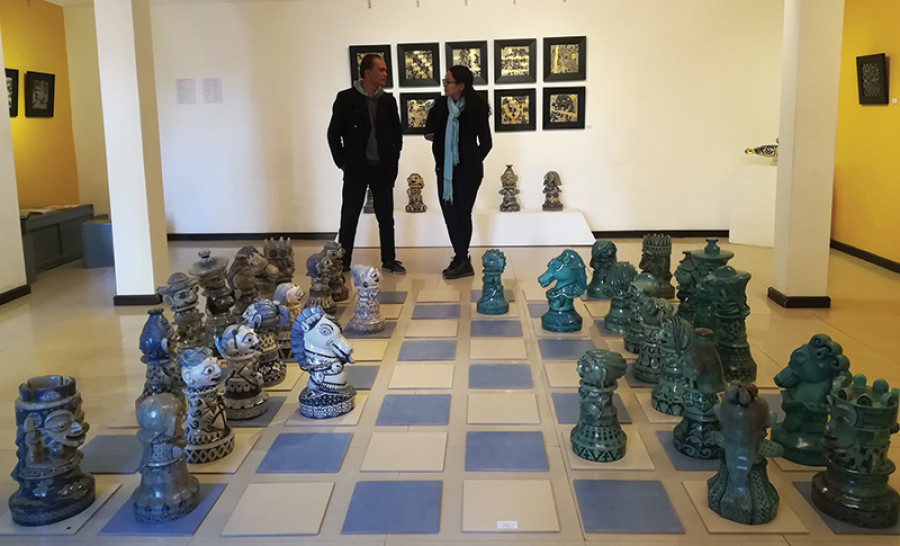Entertainment
Gender gambit
The sun had already set and a light evening mist was drifting in on the crowd waiting outside the Siddhartha Art Gallery last Sunday, when ‘Nari Satranj’ finally opened to the public.
Kurchi Dasgupta
The sun had already set and a light evening mist was drifting in on the crowd waiting outside the Siddhartha Art Gallery last Sunday, when ‘Nari Satranj’ finally opened to the public. It is the latest offering from the studio of Nepal’s premier ceramicist Gopal Das Shrestha (b. 1965), popularly known as Kalapremi Shestha. With nearly four decades of experience under his belt, Kalapremi has been immersed in the practice of traditional Japanese pottery ‘raku’ for more than a decade now and ‘Nari Satranj’ is a culmination of his creative finesse, his exemplary skills as a ‘raku’ practitioner and a resolution for his socio-political concerns.
The title roughly translates into ‘A Game of Women’s Chess’ and the series is embodied in 53 pieces, unlike the traditional 32 of satranj (or the Western chess and Nepali buddhichal). Individually hand moulded out of a combination of local Nepali clay from Thimi and the Tarai, kaolin (china clay) and ball clay, each figure ranges between 18 inches and two feet and weighs between 7 to 12 kilograms. Kalapremi has been preparing for this series for more than 10 years, making sketches and doing research. The actual creating process involved at least two weeks each for the individual figurines. The gleaming surfaces are liberally inscribed with motifs that overlay the characteristic delicate fissures of raku—the larger, air induced dragon claws and the finer, web-like spider claw rifts that are induced by dipping the fired, red hot pieces in cold water. The motifs themselves, tattooed on to the figures in rich hues of cobalt, are drawn from contemporary art, Chinese symbols and traditional folk art forms of Nepal.
Kalapremi has been following the discourse around traditional tattoos in Nepal for years now. At the opening, he briefly outlined his findings on the subject, with particular emphasis on the many negative associations it had when inscribed on ‘higher-caste’ female bodies. In 2015 Kalapremi showcased ‘Masculism’, a series centred on the bull at this very venue, in which he had turned the signifier of absolute male supremacy, the bull, upon itself and presented it as a victim of social violence and feminine aggression. ‘Nari Satranj’, however, comes as a resolution to that conflict and portrays women as confident leaders in all fields of life, including politics. And the tattoos marked onto their bodies therefore turn into jubilant celebrations of their newfound freedoms and successes. I quote one of his own poems here, which he reads out as an accompanying text to the ‘Nari Satranj’ series:

Since the time Mughals ruled India,
When
“I”
“Men”
Won, lost, became martyred
In the game of chess;
You
applied
“your”
Ointment of a woman’s smile
on our wounded bodies -
We smiled at you,
You would be happy!
It’s
“I”
Who has been battling as
the chess pieces:
Pawn
Bishop
Rook
Knight
Queen and King
I am exhausted now.
you have learnt to battle;
and successfully manifest yourselves
as the chess pieces.
you have wrestled and
vanquished me in
politics, diplomacy and in other fields.
The world today,
Is run by you
Your chess pieces
Battle,
win, lose, be a martyr
then,
I shall be ready
to apply ointment on your
wounded body,
to come before you
and make you happy
wearing the bangles and tika
left behind by you.
Well, a bit tongue in cheek I must admit, and perhaps not so far from what ‘Masculism’ had drawn on for he clearly expresses a vanquished chauvinism in the poem. But the precise beauty of the massive pieces, whose elegance somehow combine the intensity of the prehistoric and the folk with the sleek engagement of the contemporary, is hypnotic and readily overshadows thematic discrepancies. Every piece is modelled on a woman’s figure with unique features, one even heavy with child. While 32 are placed on the chess board itself, 18 more wait in queue as future substitutes eagerly hoping to replace those on the board, echoing the real life game of politics. And is perhaps an askance reference to the socio-economic tug of war that the genders are playing out at the moment.
The pieces draw formal inspiration from the traditional pottery from Dang Deukhuri in the Tarai, but are easily recognisable as rooks, pawns, bishops and the rest. Kalapremi has incidentally replaced the conventional black team with a copper carbonate glazed entourage in brilliant turquoise. The artist has also added three more figures to the set, placed on separate pedestals, which are modelled after the three actual women who have recently shaped the course of contemporary Nepali arts: Curator/gallerist Sangeeta Thapa, artist Ashmina Ranjit and the recently deceased art historian, Dina Bangdel. This triad is called ‘Guardians of the Nepali Art Scene’. The exquisite glazed ceramic tiles that adorn the walls provide visual and thematic support to the chess board and its players.
The exhibition will continue till January 15 and it looks set to become a part of public memory and the narrative of Nepali contemporary art.





 16.12°C Kathmandu
16.12°C Kathmandu










